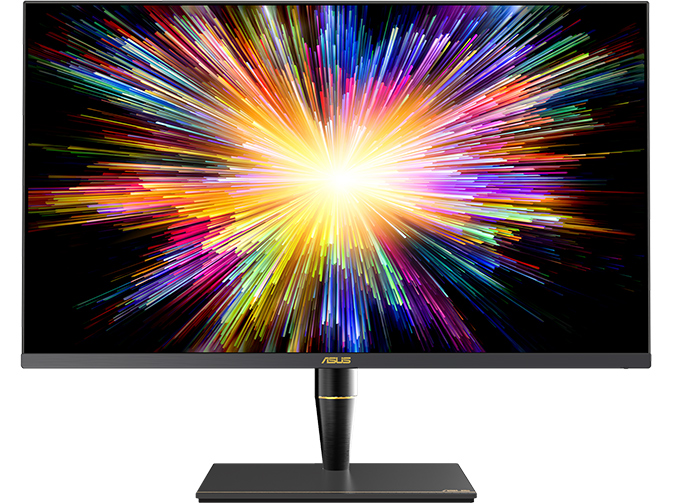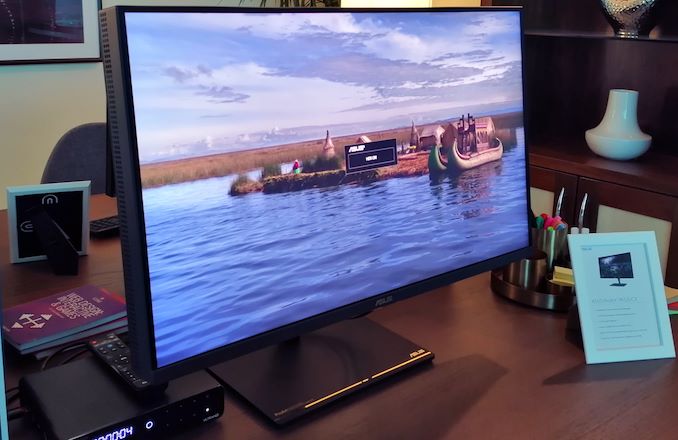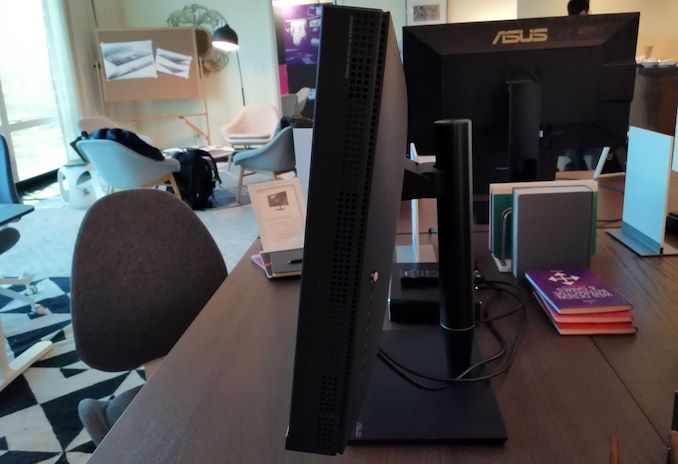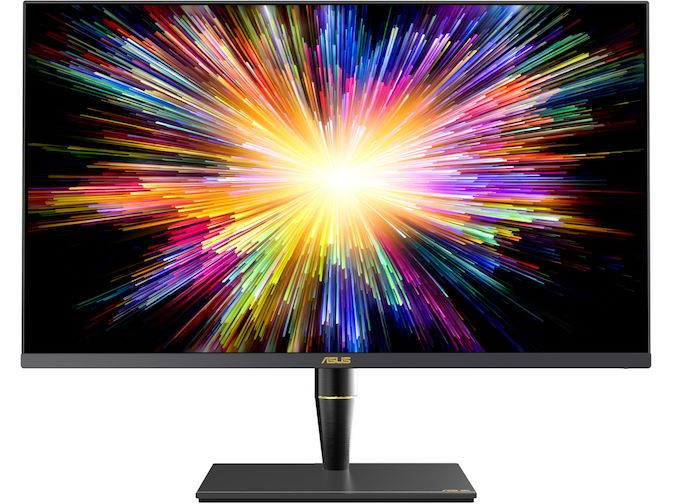ASUS at CES 2019: ProArt PA32UCX 4K Monitor with 1000-Zone FALD Unveiled
by Anton Shilov on January 11, 2019 5:00 PM EST
ASUS introduced its new flagship professional display at CES. The ProArt PA32UCX supports everything that one might expect from a 2019 professional monitor, including a 4K Ultra-HD resolution along with support of the DCI-P3 and Rec. 2020 color spaces as well as Thunderbolt 3 connectivity, but its key feature is a unique FALD backlighting with 1000 zones.
The ASUS ProArt PA32UCX monitor is based on a 10-bit 32-inch IPS panel that can reproduce 1.07 billion colors and features a 3840×2160 resolution presumably at 60 Hz. The custom panel is outfitted with an exclusive Mini LED-based backlighting that enables 1200 nits peak brightness as well as a 1000-zone full array local dimming (today’s leading-edge LCDs feature a 384-zone FALD) as well as 0.003 - 0.001 nits lowest luminance. To control the backlighting, ASUS had to order a custom display scaler and then test it for months to hit the right contrasts, color uniformity, and other targets it needed.
The manufacturer says that the ProArt PA32UCX display covers 97% of the DCI-P3 as well as 89% of the Rec. 2020 color spaces used for video post-production nowadays. Besides, it supports HDR10 as well as hybrid log gamma (HLG) HDR formats, but ASUS says nothing about Dolby Vision support. Since the monitor is only announced formally, ASUS does not disclose any details regarding its internal 3D LUT (look-up table) for HDR color gradations, but I would expect something very professional grade (e.g., 24-bit, which is more accurate than 14-bit). Meanwhile, ASUS says that the ProArt PA2UCX not only meets, but exceeds requirements for VESA’s DisplayHDR 1000 logo.
As far as connectivity is concerned, the monitor has one DisplayPort capable of DCI-4K with 4:4:4 chroma subsampling at 50/60 Hz, two Thunderbolt 3 ports capable of the same capability (and supporting daisy chaining), as well as an HDMI 2.0 input capable of DCI-4K with 4:2:2 at 50/60 Hz.
| Specifications of the ASUS ProArt Mini LED Display | |
| ProArt PA32UCX | |
| Panel | 32" IPS |
| Native Resolution | 3840 × 2160 |
| Maximum Refresh Rate | 60 Hz |
| Response Time | unknown |
| Brightness | 1200 cd/m² (peak) |
| Contrast | high |
| Viewing Angles | 178°/178° horizontal/vertical |
| HDR | HDR10, HLG |
| Backlighting | Mini-LED-based 1000-zone FALD |
| Pixel Pitch | 0.1845 mm² |
| Pixel Density | 138 ppi |
| Display Colors | 1.07 billion |
| Color Gamut Support | DCI-P3: 98% Adobe RGB: ? Rec. 2020: 80% sRGB: ? |
| Aspect Ratio | 16:9 |
| Stand | Hight, Tilt, and Swivel adjustable |
| Inputs | 1 × DisplayPort 2 × Thunderbolt 3 1 × HDMI 2.0 |
| USB Hub | ? |
| Launch Date | Spring 2019 |
ASUS plans to launch its ProArt PA2UCX officially this Spring, but the company does not specify when exactly. Meanwhile, it should be noted that it takes ASUS a long time to finalize its high-end monitors. Traditionally, the manufacturer does not pre-announce MSRP of the display, but since we are talking about a 32-inch LCD with a unique 1000-zone Mini LED-based FALD, it will cost thousands of dollars.
Related Reading:
- ASUS ProArt PA32U Display: 4K, 1000 Nits Brightness, 95% DCI-P3, 85% Rec. 2020
- ASUS Unveils ProArt PQ22UC OLED Monitor: 4K, 99% DCI-P3, 0.1 ms Response Time
- EIZO Announces ColorEdge Prominence CG3145: 4096x2160, 98% P3 and HDR10
Source: ASUS















33 Comments
View All Comments
Lau_Tech - Friday, January 11, 2019 - link
"contrast : high" lolThat many zones in 32inches lcd is unheard of. But just as key is the dimming algorithm implemented to ensure that low APL gradients and shadow detail are not lost.I'm abit skeptical of Asus ability to deliver given that actual TV manufacturers (looking at you Samsung,) still struggle to get it right.
The other issue is cost. If this ends up costing more than a high end lcd or oled TV it may price itself out of any reasonable consumers list.
nevcairiel - Friday, January 11, 2019 - link
Well, it is a professional display, not a consumer display. So expect a high price.TristanSDX - Friday, January 11, 2019 - link
where is 27 inch gaming monitor with mini LED ? AUO showed it several times, but on CES total silence, strange.Beaver M. - Monday, January 14, 2019 - link
Nothing is strange with AUO.Horrible quality? Totally normal for them!
Announcing things for next year, then not even delivering it 2 years later? Totally normal for them!
Skfrts - Friday, January 11, 2019 - link
The percentages don't matchzepi - Saturday, January 12, 2019 - link
Why nobody does dual-LCD? One B&W one and and color one on top of it?That should give about million to one contrast. With some loss to efficiency.
nevcairiel - Saturday, January 12, 2019 - link
Heard about it from one single vendor at CES, and already demanding that everyone has it.Valantar - Saturday, January 12, 2019 - link
"Some" loss to efficiency - a 50% brightness loss at iso power is to be expected, anything less would be "good". So, achieving decent brightness would thus require significantly more powerful backlighting. Then there's cost and heat, and the complexity of tuning the display driver to ensure good image quality (this could easily lead to overblown contrast, and would need significant tuning for balance).Death666Angel - Saturday, January 12, 2019 - link
I would imagine that would add a whole lot of pixel response time issues as well. Tuning displays for overdrive is already difficult enough, tuning two different panels for the same thing seems and order of magnitude more difficult. I doubt this is a solution to any problem facing monitors right now. OLED and MicroLED seem a more doable and future proof way of increasing contrast. OLED burn in can be mitigated by software if they finally start working on it.a5cent - Saturday, January 12, 2019 - link
Yup!Dual layer LCD is just patching of stuff that sucks. It really would be better to build something that doesn't suck to begin with. I've given up hope for OLED PC monitors. The first MicroLED to hit the market is mine however ;-)